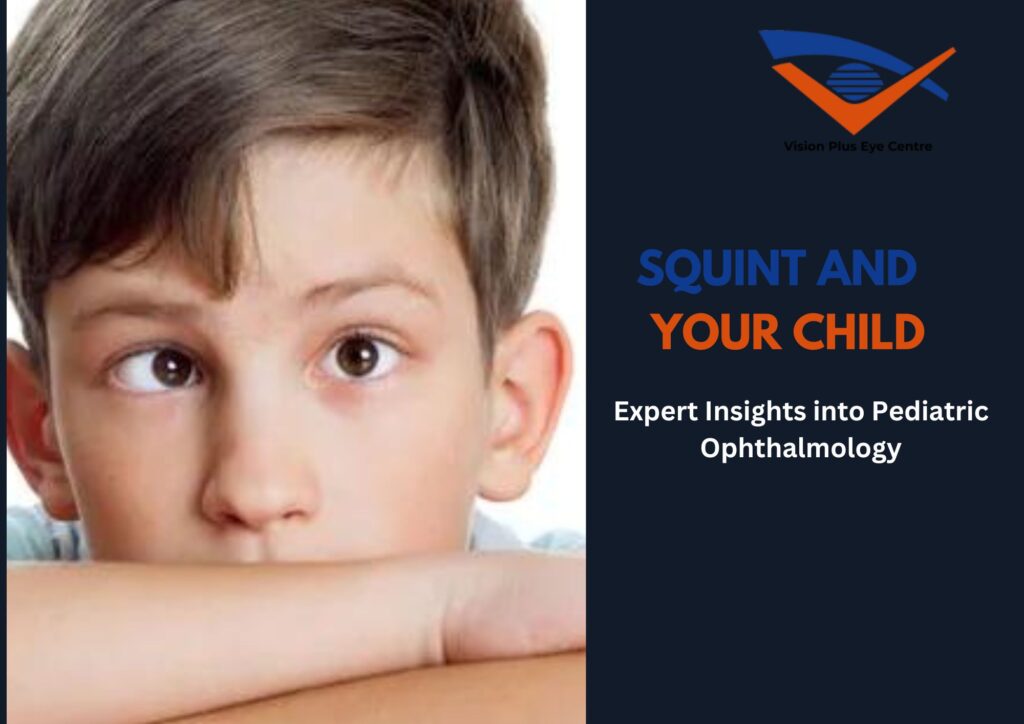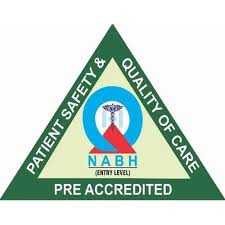
Introduction
When it comes to your child’s health and well-being, their vision is a top priority. If you’ve noticed that your child’s eyes don’t align perfectly, you might be concerned about squint, also known as strabismus. This condition can affect a child’s vision and quality of life, but with the right care from a pediatric ophthalmologist, it can often be corrected or managed effectively. In this blog, we will provide expert insights into squint and pediatric ophthalmology to help you understand this condition, its diagnosis, and available treatment options.
Understanding Squint in Children
Squint, or strabismus, is a condition where the eyes do not align properly. One eye may turn inwards, outwards, upwards, or downwards while the other eye remains straight. This misalignment can be constant or intermittent. It’s essential to know that a slight misalignment in a baby’s eyes is common and typically corrects itself during the first few months of life. However, persistent or worsening squint eye should be evaluated by a pediatric ophthalmologist.
Common Types of Squint:
- Esotropia: One or both eyes turn inward.
- Exotropia: One or both eyes turn outward.
- Hypertropia: One or both eyes turn upward.
- Hypotropia: One or both eyes turn downward.
Diagnosing Squint in Children
The diagnosis of squint involves a thorough eye examination, which can be performed by a pediatric ophthalmologist. Here’s what you can expect during the diagnostic process:
- Medical History: The ophthalmologist will ask about your child’s medical history, including any family history of eye conditions or vision problems.
- Visual Acuity Test: This test measures your child’s visual sharpness to identify any refractive errors (nearsightedness, farsightedness, or astigmatism).
- Cover-Uncover Test: The doctor will cover one eye at a time while observing the uncovered eye for any movement or deviation.
- Prism and Alternate Cover Test: This test helps determine the type and degree of squint. It involves using prisms to measure the angle of misalignment and the direction of deviation.
- Refraction Test: Your child may undergo a refraction test to determine the need for eyeglasses.
- Dilated Eye Examination: The ophthalmologist may use eye drops to dilate your child’s pupils, allowing for a more detailed examination of the eye’s internal structures.
- Evaluation of Eye Movements: The doctor will assess your child’s eye movements to understand how the squint affects their vision.
Treatment Options for Pediatric Squint
The treatment of squint in children depends on several factors, including the type and severity of the squint, the child’s age, and the underlying cause. Treatment options may include:
- Eyeglasses: In some cases, especially when the squint is related to refractive errors, prescription glasses can help correct the alignment of the eyes.
- Eye Exercises (Orthoptics): Eye exercises are designed to improve eye coordination and strengthen the eye muscles. These exercises are often prescribed by a pediatric orthoptist.
- Eye Patches: For children with amblyopia (lazy eye), an eye patch may be prescribed to encourage the use of the weaker eye and improve visual acuity.
- Botox Injections: In certain situations, Botox injections can be used to temporarily weaken overactive eye muscles, allowing for better alignment.
- Surgery: When other treatments are not effective, or the squint is due to anatomical issues, surgical intervention may be required. Squint surgery aims to realign the eye muscles to restore proper eye alignment.
- Vision Therapy: This comprehensive program of vision exercises and activities is designed to improve visual skills and processing, often used in conjunction with other treatments.
Benefits of Early Intervention
Early intervention in the case of pediatric squint is crucial for several reasons:
- Vision Development: Early treatment can help ensure normal visual development, reducing the risk of amblyopia (lazy eye).
- Improved Eye Alignment: The earlier squint is treated, the better the chances of achieving optimal eye alignment.
- Enhanced Quality of Life: Correcting squint can boost a child’s self-esteem, social interactions, and overall well-being.
- Prevention of Complications: Early treatment can prevent complications related to untreated squint, such as double vision and depth perception problems.
The Role of Pediatric Ophthalmologists
Pediatric ophthalmologists are eye doctors who specialize in diagnosing and treating eye problems in children. They receive specialized training beyond that of general ophthalmologists to address the unique needs of young patients. When it comes to squint in children, pediatric ophthalmologists play a crucial role in providing expert care and guidance.
Key Roles of Pediatric Ophthalmologists:
- Accurate Diagnosis: Pediatric ophthalmologists are skilled in identifying various eye conditions, including squint, and determining the most appropriate treatment.
- Child-Friendly Approach: These specialists understand how to communicate and interact with children to make them feel comfortable during examinations and treatment.
- Coordination of Care: Pediatric ophthalmologists often work closely with other healthcare professionals, such as orthoptists, to provide comprehensive care.
- Surgical Expertise: When surgery is necessary, pediatric ophthalmologists have the skills and experience to perform delicate eye surgeries on children.
- Long-Term Management: These specialists monitor a child’s progress and make adjustments to treatment plans as needed, ensuring the best possible outcome.
Myths and Misconceptions
There are several myths and misconceptions surrounding squint in children. It’s essential to address these to ensure parents have accurate information:
- Myth: Squint in Children Always Goes Away on Its Own. While slight misalignment in babies may resolve, persistent or worsening squint often requires intervention.
- Myth: Squint Is Only a Cosmetic Issue. Squint can affect a child’s vision, causing problems like amblyopia, which can have long-term consequences.
- Myth: All Squint Cases Require Surgery. Many cases of squint can be managed with non-surgical approaches like eyeglasses or exercises.
- Myth: Squint Is Always Caused by Genetics. While genetics can play a role, squint can also be caused by other factors such as refractive errors or neurological conditions.
The Emotional and Psychological Impact
Squint can have a significant impact on a child’s emotional and psychological well-being. Children with squint may experience:
- Low Self-Esteem: They may feel self-conscious about their appearance, especially if they are teased or bullied by peers.
- Social Isolation: The fear of being judged or misunderstood can lead to social withdrawal.
- Academic Challenges: Squint can affect a child’s ability to read and concentrate, potentially impacting their academic performance.
- Emotional Stress: Coping with the challenges of squint can cause emotional stress for both the child and their family.
It’s important for parents to provide emotional support, seek early treatment, and ensure their child’s self-esteem is nurtured.
Success Stories in Pediatric Ophthalmology
The field of pediatric ophthalmology has witnessed remarkable success stories in treating children with squint. Here are a few inspiring examples:
- Emma’s Story: At the age of three, Emma was diagnosed with squint and amblyopia. Through a combination of eyeglasses and vision therapy, she achieved excellent eye alignment and vision improvement.
- Liam’s Journey: Liam’s exotropia was detected at a young age. With the help of a pediatric ophthalmologist, he underwent successful squint surgery, restoring proper eye alignment.
- Ava’s Struggle: Ava had esotropia and struggled with self-esteem issues. With a combination of eye patches, glasses, and vision therapy, she not only corrected her squint but also excelled academically and socially.
These success stories highlight the importance of early intervention and the dedicated work of pediatric ophthalmologists in improving the lives of children with squint.
Conclusion
Squint is a common condition in children that can have far-reaching effects on their vision and overall well-being. However, with early diagnosis and appropriate treatment, many children can achieve proper eye alignment and develop excellent visual acuity. Pediatric ophthalmologists play a crucial role in this process, providing expert care and support to both children and their families. By dispelling myths and addressing the emotional impact, parents can ensure that their children receive the best care and support in their journey towards healthy eyes and improved self-esteem. If you suspect your child may have squint, consult a pediatric ophthalmologist to start the path towards better vision and a brighter future. Discover expert care for pediatric squint at Vision Plus Eye Centre. Our specialized pediatric ophthalmologists provide precise diagnosis and tailored treatments. Ensure your child’s vision thrives with our compassionate team. Book an appointment today for expert insights into pediatric ophthalmology.
Call Now at 0120-2481481, 2480480 +91 88003 13134 or email us at info@visionplus.net.in.
Book an Online Appointment: https://visionplus.net.in/contact/

